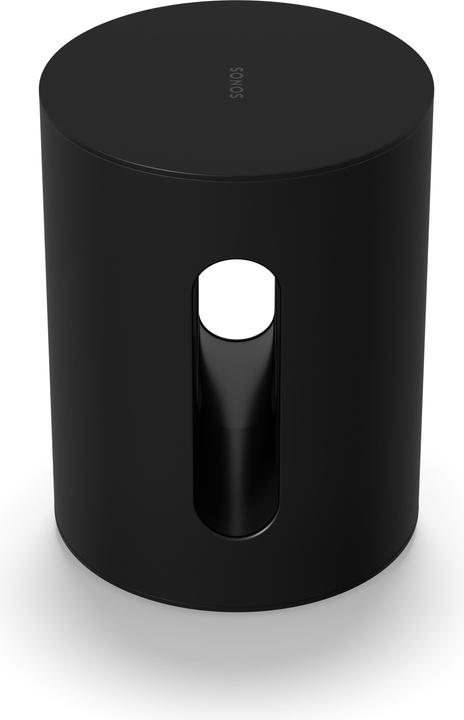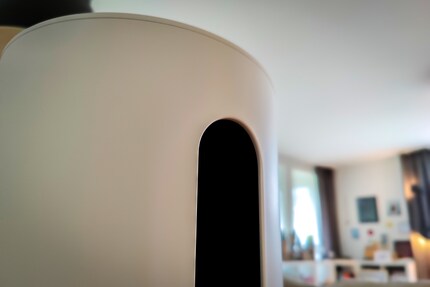

Testing the Sub Mini: Sonos’ small subwoofer has a surprising amount of oomph
Even before it officially goes on sale on 6 October, I got to test Sonos’ new subwoofer: the Sonos Sub Mini. It has decent bass – but its added value lies elsewhere.
I don’t know about you, but I associate the word «mini» with «inconspicuous», «slender» and «small». However, there’s absolutely nothing inconspicuous, slender or small about Sonos’ new subwoofer. «On the contrary,» I said to myself, panting heavily, as I tried to lift the cylindrical, nearly seven-kilo beauty out of its packaging for the first time (and almost twisted my back because of my underestimation).
And yet it bears the name «Sub Mini».
Mini.
Nice joke, Sonos.
But not being so mini and having a lot of body – like a good wine – also has advantages. Especially for a subwoofer that has to fill the room with a good amount of bass. And if you don’t want to spend 800 francs for the (slightly) larger Sonos Sub, you can get a really good deal with the Sonos Sub Mini, which is 300 francs cheaper.
Style and hardware: what can the Sonos Sub Mini do?
Let’s stick with appearances for a moment. Sonos’ Sub Mini not only weighs a lot, but, at 22.8 cm in diameter and 30.8 cm in height, it’s only a little less bulky than the rectangular Sonos Sub with its 40.2 × 15.8 cm footprint and 39.5 cm height. The surface is matte – either white or black. I prefer the white version. Not just because it goes better with my furniture. It’s also less susceptible to dust and fingerprints.

There’s a lot of power under the acoustically sealed bonnet. We’re talking about two class D digital amplifiers and two circular woofers. As with the sub – where the woofers are larger and more rectangular – the latter are installed in a gap in the housing opposite so that the vibrations caused by their sound waves cancel each other out. And with good reason: even if you crank the bass up to the max, the cabinet itself never vibrates. It’s good. You want to feel the bass, not like your apartment is falling apart. Because if everything the subwoofer touches is rattling and rattling, you don’t want a subwoofer.
To give you a better idea, I’ve showcased this in the video below with my professional vibration meter standing on top of the Sub Mini:
Setting up the subwoofer was fast:
- Connect it to the two-metre power cable.
- Turn it on.
- Connect it via the Sonos app on your smartphone.
Once it’s set up, all you have to do is connect the Sub Mini to the desired room, as Sonos so nicely puts it. In my case, for example, with the living room where the Sonos Arc is, or with the bedroom where I placed my Sonos Beam. Being able to simply move the subwoofer from one room to another in the app is practical if you need it in another room. Typical Sonos convenience.
As usual with Sonos, the devices communicate with each other via your Wi-Fi network, never via Bluetooth. This is better for the audio quality. And thanks to the 5 GHz connection that some Sonos devices have supported since the switch to the S2 app (Sonos One, Sonos One SL, Sonos Five, Sonos Sub and Sonos Sub Mini), the connections are now extremely stable and significantly less susceptible to interference from other networks. By the way, you can see exactly which Sonos speakers the Sub Mini can be connected to here. Spoiler: the Sonos Arc, Beam und Ray are all included.
But I recommend that you only get the Sub Mini for small to medium-sized rooms. Bedrooms. Gaming caves. Hobby rooms. Spaces like that. The Sub Mini is probably too small for larger (living) rooms – mine is about 35 square metres. I’d go with the Sonos Sub.
In practice: a lot of power, but the actual added value is something else...
Now for the practical part of the test. Firstly, I set up the Sub Mini in my Beam system, which in turn is connected to my television. With Sonos, however, you can only do so with the Trueplay function, and that’s only available in the Sonos app on iPhones and iPads. If you’re an Android user, you’re left in the dark and can’t get the best out of your Sonos devices.
«It’s really, really stupid, » said audio expert Livia Gamper during my Sonos Beam test.
So while I’m shuffling around the room waving my phone around, the Beam emits signals that remind me of the sonar on a submarine. Among other things, the bass management is optimally tuned to my room. Now the real test begins. I start with the first scene from the musical «The Greatest Showman». P. T. Barnum’s silhouette is backlit, the circus audience stomp their feet heavily in the stands to match the beat, the bass rumbles out of the Sub Mini with good definition and full weight. Then the bass of the music kicks in. I can feel it in the pit of my stomach – in a good way! – but not enough. I’m just used to more bass from the Sonos Sub. I briefly tweak the bass in the equalizer in the Sonos app. Ah, now it’s OK. All without any weird rattling or distortion. Good quality.
For comparison, I watch the same scene with the larger Sonos Sub. Unsurprisingly, the subwoofer gets a good deal more thump without me having to adjust the equaliser, even in my rather small bedroom, where I can only place the subwoofer directly against a wall. This is not ideal for the acoustics. Simply put, the wall can stop sound waves, draining power from the bass. A simple, effective remedy for stationary waves is to change the subwoofer’s position: you simply place it anywhere in the listening area and then systematically move it around the room. The ideal place for the subwoofer is where the sound is best.
Finally, I watch the same scene again without the subwoofer. The only bass now comes from the Sonos Beam’s four elliptical mid-range drivers. I’m amazed to find that the bass of the Sonos Beam has a lot of oomph even without a dedicated subwoofer. On the other hand, the middle and high frequencies audibly lose their power and sound much less clear.
While we’re at it, putting it simply: the added value of the Sub Mini isn’t the slightly stronger and heavier bass. The real added value lies in the fact that the connected speakers – whether Arc, Beam, Play or Ray – sound better through the dedicated subwoofer because they can concentrate much better on the middle and high frequencies. This in turn contributes to a significantly improved soundscape.
Verdict: not just for Sonos beginners
Who is the Sonos Sub Mini for? On the one hand, it’s for Sonos beginners who want to integrate a real subwoofer into their Sonos system for the first time, but are put off by the 800 euro/franc price tag of a Sonos Sub. 499 francs at the time of this test sounds more forgiving on the wallet. On the other hand, it’s also for those who aren’t planning an additional subwoofer for rooms that are too large – the Sub Mini would need even more body to fill them properly with bass. But then we’d be back with the Sonos Sub.

By the way, the scene described above is representative of a whole series of films that I have watched specifically for the test in the past few days. These include the rocking queen biopic «Bohemian Rhapsody», Denis Villeneuve’s dark, futuristic thriller «Blade Runner: 2049» and the action hit «Edge of Tomorrow». I watched the latter in a DTS HD Master Audio 7.1 soundtrack on Blu-Ray. It was actually mixed so carefully and brilliantly that I made a note of it for my next test: Sony’s latest flagship soundbar, the HT-A7000.
Stay tuned.
I write about technology as if it were cinema, and about films as if they were real life. Between bits and blockbusters, I’m after stories that move people, not just generate clicks. And yes – sometimes I listen to film scores louder than I probably should.



